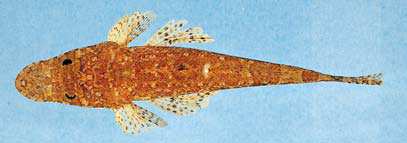PLATYCEPHALIDAE
Flatheads
By Hisashi Imamura
 Cociella punctata |
 Grammoplites scaber |
 Inegocia japonica |
 Platycephalus indicus |
 Rogadius pristiger |
 Rogadius serratus |
 Suggrundus macracanthus |
 Sunagocia otaitensis |
 Thysanophrys chiltonae |
|
Small to large marine fishes, usually ranging from 7 to 50 cm, a few attaining 70cm or greater. Body elongate. Head moderately or strongly depressed, usually armed by many spines and ridges. Eye small to relatively large. Snout prominent. Mouth large, lower jaw longer than upper. Teeth present on upper and lower jaws, vomer and palatine. Gill rakers few, relatively short or mere stubs. Gill membrane free from isthmus. Two dorsal fins well separated; 1st dorsal fin with VI-X spines, first short, isolated or scarcely connected to second; second dorsal fin with 10-15 soft rays. Anal fin with 10-15 soft rays; no spines present. Pelvic fin with 1 spine and 5 soft rays. Lateral line complete, with about 30 to more than 100 scales. Upper surface of body covered by ctenoid scales and lower by cycloid. Color: usually dark above and pale below; the dark colors with various shades of brown, gray or black. Similar family occurring in the area. Plectrogeniidae and Bembridae: lower jaw shorter than or equal to upper jaw. Parabembridae: pelvic fin with 1 spine and 5 soft rays. Holpichthyidae: head and body extremely depressed and lateral line with bony plates. Percophidae: head without spines and ridges. Remarks. Platycephalids known from less than 300 m, most found at less than 100 m and inhabiting on the mud, sand, rocky shore and coral reef. Many species excellent for eating. |

|
|